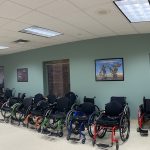More than 80% of adults experience low back pain at some point in their lives. For many of them, that pain becomes chronic, and treatment outcomes vary widely.
To address this issue, researchers from the University of Pittsburgh and UPMC were recently awarded a five-year, $16.8 million grant from the National Institutes of Health to establish the Low Back Pain: Biological, Biomechanical, Behavioral Phenotypes Mechanistic Research Center (LB3P MRC). Using a wide variety of data to categorize patients into chronic low back pain (CLBP) subgroups, the center aims to improve targeted and personalized treatments while reducing the use of opioids.
The LB3P MRC was established with NIH funding from its Helping to End Addiction Long-term, or the NIH HEAL, Initiative, which launched in April 2018 to improve treatments for chronic pain, curb the rates of opioid use disorder and overdose, and achieve long-term recovery from opioid addiction.
“Numerous factors contribute to low back pain, and because every patient is unique, they do not respond to treatments in the same way. Opioids are not necessarily the answer for this type of chronic pain,” said Gwendolyn Sowa, M.D., Ph.D., LB3P MRC director, chair of Pitt’s Department of Physical Medicine and Rehabilitation and director of the UPMC Rehabilitation Institute.
“Prior efforts to individualize treatments have been based on isolated characteristics,” she continued. “Our approach of integrating the biological, biomechanical and behavioral contributors to CLBP, combined with novel mathematical modeling, will provide predictive tools to help personalize treatments like never before.”
Researchers from Pitt’s Schools of Medicine, Health and Rehabilitation Sciences, Engineering and Education, as well as UPMC, will contribute to the new center.
Housed at Pitt and UPMC, the LB3P MRC will leverage unique strengths of Pitt’s research program to collect and analyze data related to patients’ biomarkers, biomechanical movement patterns, behaviors and clinical characteristics in connection to CLBP. Administrative, clinical and informatics support, all guided by Pitt leaders, will organize, process and integrate the data, ultimately developing a comprehensive characterization of patients with CLBP and their responses to various medications and non-medication-based treatments.
“It has become evident that CLBP is incredibly complex and comes in different shapes and sizes, like cats. We wouldn’t treat a tiger the same as a house cat even though they are both technically felines, and for this same reason, we should not treat all CLBP human patients the same,” said Nam Vo, Ph.D., LB3P MRC associate director and associate professor of orthopaedic surgery at Pitt. “We have the infrastructure, the clinical and scientific resources and, now, the funding, to address this problem with a truly multidisciplinary approach.”
This research is funded by NIH grant 1U19AR076725-01. Eight other Pitt and UPMC projects were funded as part of the HEAL initiative.











